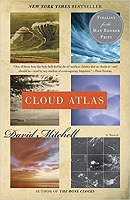Fragmentation can be fun!

I’ve come to realize over the years that many of my favorite novelists — Don DeLillo, Umberto Eco, Kurt Vonnegut, E.L. Doctorow, etc. — are categorized as “postmodern.” This means that, among other things, they tend to be skeptical of rationality and don’t always observe narrative traditions, rather juxtaposing fragments of storytelling in novel ways.
At the same time, I’ve found my own reading habits have changed. I no longer just read one book from beginning to end, but will begin one and then put it down to start another — even though I’m enjoying the first — and then maybe even start a third. Then I may — or may not — pick up the second book and finish it, and then get back to the first.
In short, I have become a postmodern reader.
It reminds me of the structure of David Mitchell’s Cloud Atlas — generally acknowledged to be a masterpiece of postmodern literature. The virtuoso writer starts five loosely related narratives spanning various periods of history, one after the other. Then, in the middle of the book, he goes back to each in turn, in reverse order (more or less, if memory serves) and brings each to a conclusion.
It’s weird, but it works, and, for me at least, Cloud Atlas was a totally satisfying read. (Nor did I need to interrupt it with other works, since Mitchell did enough interrupting for both of us.)
In a sense, my new postmodern reading habit mimics the same structure. Recently, I started Tommy Orange’s There There — a truly wonderful if depressing sketch of Native-American life — but sought relief from its unrelenting literariness by escaping to another of the Sister Fidelma mysteries, Valley of the Shadow.
As always, Peter Tremayne’s exquisite depictions of Celtic life in the 7th century were quite soothing. But then I put the mystery down to start a book urgently recommended by a friend, Daniel Mason’s The Piano Tuner, a novel set in the Burma of the British Empire, where events may be headed into the heart of darkness.
In all likelihood, I will finish Piano Tuner first, then go back and quickly finish Valley of the Shadow before returning to the Orange book and finishing it.
Postmodernism preceded the digital age, but it seems to me the ability and, yes, the desire to read novels in this fragmented fashion may come from the constant fragmentation of digital content we are relentlessly exposed to.
And I include streaming television in this. Nowadays, we can binge-watch two, three, or more episodes at once. But we can also interrupt any episode at any time with the knowledge that Netflix or Hulu will hold our place and let us resume whenever we are ready. Needless to say, in the meantime, we may watch a dozen other shows.
Even cable, by repeating movies regularly, gives us the opportunity to watch the last half-hour one day, the first half-hour another day, and the middle whenever we can. (Admittedly, this works better with movies you’ve already seen, but that is most of the movies on cable.)
As the subscription model for movie theaters gains traction, who knows? We may become postmodern moviegoers. AMC’s A-List lets you see three movies a week for $19.95 a month (think of the popcorn profits), including on the same day and movies you’ve seen before. Watch a film, catch the beginning of another before you leave, and then finish it up when you come back next week. Fragmentation can be fun.

_80_124.png)